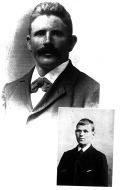Name Frank and | ||
 | ||
Frank Samuelsen (26 February 1870 – 1946) and George Harbo (14 September 1864 – 1909) were Norwegian-born Americans who in 1896 became the first people ever to row across an ocean. Their time record for rowing the North Atlantic Ocean was not broken for 114 years, and then by four rowers instead of two.
Contents
George Harbo
Gottleb Harbo Ragnhildrød was born in the community of Sandar in Sandefjord in Vestfold, Norway, on September 14, 1864. He was the older of the two men and the instigator of the idea to row across the Atlantic Ocean. George had been in the merchant marine, a surf fisherman and a part-time pilot before clamming in his own boat, of his own building, off the Jersey Shore with his younger friend Frank Samuelsen. By 1886 he was settled in the United States with his wife, Anine Brynhildsen.
Frank Samuelsen
Frank Samuelsen was born Gabriel Samuelsen in a seacoast town, Farsund in Vest-Agder, Norway on February 26, 1870 and went to sea at age 17, spending six years in the merchant marine. Samuelsen was quickly promoted up the ships chain-of-command to boson's mate. After six years at sea covering many of the worlds oceans Frank decided to make New York a permanent port. He headed for the fishing villages along the Jersey coast where his brother lived and there he would meet up with George Harbo. They became friends and clammed together.
Voyage
The inspiration for their scheme was Richard Kyle Fox (1846–1922), the publisher of National Police Gazette. Fox was editor and publisher of the Police Gazette from 1877 until his death in 1922. He had backed previous schemes that today might feature in the Guinness Book of Records. Fox offered a prize of $10,000 to the first men to row across the Atlantic. However, no contemporary sources exist that confirm this money was ever offered by Fox or the Police Gazette or that the men were expecting a substantial sum from the Gazette. Numerous sources report the men were expecting either no money or only whatever money could be raised from exhibitions following successful completion of the voyage. Sources also show Fox and the Police Gazette offered and provided towing of the 'Fox' to Bay Ridge, Brooklyn—the last outside propulsion used by Harbo and Samuelsen until reaching Europe; payment of expenses incurred by the American consulate in Le Havre for their food, clothing, and temporary shelter upon reaching the continent; two gold medals commemorating the achievement; and publicity within the pages of the Police Gazette. The Gazette was also the only newspaper willing to attach its name to the endeavor as others considered it too risky.
Using their life savings, an 18-foot ship-lap (clinker-built) oak rowboat was built with water-resistant cedar sheathing with a couple of watertight flotation compartments and two rowing benches. The boat was fitted with rails to help them right it if capsized, a feature that saved their lives in mid-ocean. The boat was carrying American flags and was named "Fox" in honor of the editor. With a compass, a sextant, a copy of the Nautical Almanac, oilskins and three sets of oars lashed safely in place, they set out from The Battery in New York City June 6, 1896, and arrived 55 days later in the Isles of Scilly off the southwestern tip of the Cornish peninsula of Great Britain.
Richard Fox came to Paris and at a dinner held in honor of the Atlantic voyagers, he handed over to each the two rowers a gold medal. They never received the fame and fortune on the lecture circuit nor even their prize money from Fox, who was photographed giving them gold medals nevertheless. However, no contemporary source exists confirming Fox had offered any significant monetary prize. The only honor they received, in addition to the gold medals, was 10 Swedish krona from King Oscar II of Sweden and Norway (which at the time was in a personal-union with Sweden).
The partners loaded their boat on a steamer for the return journey. The steamer ran out of coal off the coast of Cape Cod, and when the Captain ordered all wooden objects aboard broken up and stoked to make steam for the remainder of the trip, Samuelsen and Harbo relaunched their boat Fox over the side and rowed back to New York. Though they soon faded again into obscurity, their time record for rowing the North Atlantic was not broken for another 114 years. Single oarsmen have since made the crossing and ocean rowing has developed into a kind of extreme sport.
Legacy
Their logbook and a journal dictated by Harbo survive to document their feat, which was worked into a dramatic account by freelance writer David W. Shaw in 1998. In 1985 folk singer Jerry Bryant wrote The Ballad of Harbo and Samuelsen which has since been recorded by many other artists including William Pint and Felicia Dale. Norwegian folk vocalist Ingvild Koksvik has written and published in 2016 the song Gabriel.
In the summer of 2010, four rowers – skipper Leven Brown (37), Ray Carroll (33), Don Lennox (41) and Livar Nysted (39), on the Artemis Investments – bested the record set by Samuelsen and Harbo by crossing the Atlantic Ocean in 43 days, 21 hours and 26 minutes. But the record for two people rowing across the Atlantic still belongs to Harbo and Samuelson.
Samuelsen and Harbo's voyage was the subject of a 2016 episode of the Futility Closet Podcast.
